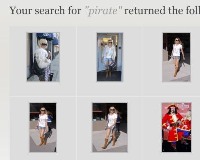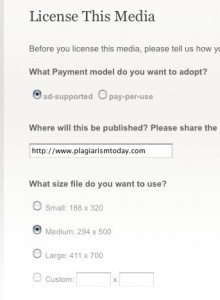GumGum: Simple Image Licensing
Earlier this week, I reported on a new WordPress plugin that made it easier than ever to insert Creative Commons images into your blog.
But what if the image you want is not available under Creative Commons and, instead is something that has to be licensed? How do you use the image without paying high licensing fees or dealing with uncertainty about the license?
GumGum may have the answer.
Its new photo licensing service makes it easy to find images that may be relevant to your content and license them, either for a token rate or free using an advertising model.
This system could be a boon for stock photographers and anyone who wants to use images on their blog as it makes it easy for photographers and licensers to get together and make exchanges, all the while going to great lengths to protect the original work.
For photographers, it may be the most fair system available, even if Webmasters might not like how some elements of the service work.
How it Works
 The GumGum process starts with a photographer uploading a group of images to the site and providing information about them, including what the image is and the CPM that they wish to charge for it.
The GumGum process starts with a photographer uploading a group of images to the site and providing information about them, including what the image is and the CPM that they wish to charge for it.
Once the image is processed, the user comes to the site later, performs a related search and gets a collection of potential candidates.
The list is often quite long, even for fairly obscure terms, but seems to focus heavily on celebrity-related images. This is likely due to issues with selling pictures of non-celebrity individuals.

Once you find the image you want, you click the image and then are taken to a page that offers you the chance to license the work. You are given two options, the first is to license it with a CPM method, which means you pay a small amount per 1000 times the image is displayed, or a advertising-based model that lets you use it for free, but with an ad overlay.
 Once you have made your selection, you then provide the URL of the site it will be appearing on and select the size that you need, choosing from small, medium, large or a custom size.
Once you have made your selection, you then provide the URL of the site it will be appearing on and select the size that you need, choosing from small, medium, large or a custom size.
Once you click the “Purchase” button, you are given access, not to the image itself, but to HTML code that enables you to embed it into your site. It not only prevents you from being able to put the image on other sites without purchasing, but prevents your visitors from simply right clicking the image and taking it for themselves.
Though this DRM is questionable at best, it undoubtedly will make many photographers very happy.
The end result is that the image will appear on your site exactly as shown at the end of this article. Obviously, I am not profiting from the advertising in this work nor do I have any control over the content, it is for demonstration purposes only.
Why It is Different
GumGum is certainly not the only microstock service on the Web. However, it combines several elements to make it an interesting, and at least somewhat unique, service.
- CPM Licensing: Though many will protect using CPM versus flat-rate licensing, it is actually more fair to the photographer and to many sites. Smaller sites, those needing only a few thousand impressions, will spend far less money and larger ones, which can usually afford to spend more, will pay the photographer more. It also creates a stream of revenue for the photographer over time rather than just a one-time fee.
- Advertising Model: Sites that can not afford the CPM fee can select the free advertising model where small ads are run at the bottom of the image. This gives “free” bloggers access to images that previously would have been closed off to them.
- Flash/JavaScript Embedding: The use of Flash and/or JavaScript to embed the image not only prevents the actual image from changing hands and offers GumGum a means to track the images, but it makes it very easy for novice Webmasters to drop the image in, without worrying about resizing the image or formatting it.
For Photographers, GumGum likely seems like a very appealing option. In addition to the above elements, GumGum also does not take a percentage of the licensing revenues. Rather, it charges a very small “shipping and handling” fee above your CPM rate (Ex: Making a .20 CPM image cost .207846425 to the end user) and earns their money from that. For advertising model licenses, GumGum does not make any revenue promises, but says it pays the full revenue for the advertisement less a flat fee.
GumGum also provides all of the image hosting, something that benefits Webmasters who are looking to offload their images, and handles all of the transactions the same as any other microstock site.
Potential Issues
The GumGum system, however, does raise some concerns and has some limitations that have to be weighed.
- Unpredictable Pricing: A .20 CPM sounds good when you’re only pulling in 2000 page views per post. However, if the article gets Dugg or otherwise goes viral, it could easily generate hundreds of thousands of pageviews. There is almost no way to predict this and your only defense is to quickly convert your license to Ad-supported in the event of a spike.
- Limited Selection: Though GumGum has a large number of images, almost all of them are celebrity related. Though this makes sense for legal reasons, there are almost no shots of objects or landscapes, something you would expect in a robust stock photo catalogue.
- Free Alternatives Exist: As I mentioned in my previous article, there is a wealth of CC-licensed works that are available for use by bloggers for free and without advertising. That collection is both more robust and is expanding rapidly. Though there does not seem to be much overlap between GumGum and the traditional CC fair, many bloggers will find all that they need for free.
- Awkward Insertion: Though the embedding is far easier than downloading the image, resizing it and reuploading it, it doesn’t allow much flexibility. I struggled to get the word wrap right on the image and that is why I had to paste the sample below under its own heading.
- Ad Block Vulnerability: I did a quick test and AdBlockPlus is able to block the ads, at least in the JavaScript version. While this is true of most ads, it does mean that the CPM for the photographer will be lower than expected when dealing with those who license the ad-based version.
Beyond those issues, many bloggers will be uncomfortable with either displaying ads on the site, especially those they do not profit from, and it remains to be seen how many will pay to “rent” an image based upon the number of views. Considering that sites such as iStockPhoto offer images for sale at such low rates.
Considering that GumGum does not even transfer the image itself, just access to it, it seems likely that many bloggers will want to stay away.
Conclusions
GumGum is a very interesting idea but the target market, bloggers and Webmasters needing very low-priced images for their site, is already very well served.
Photographers will likely take a great interest in the site as it enables them to reach that market while both protecting their work and obtaining a steady stream of income. Bloggers, however, aren’t likely to find that much interesting.
Though there are obvious exceptions to that rule, such as gossip bloggers and those that deal heavily with celebrity news, most are likely going to be served adequately by the Creative Commons community and can find what they need on sites such as Flickr or by using the PhotoDropper plugin.
In the end, the success of GumGum is going to hinge solely on the quality of the photographs it offers. If it can better serve bloggers than the existing system, it has a bright future ahead of it. However, that is going to be an uphill battle.
Sample Image
The best result when you search for “Pirate”.
Video Introduction to GumGum
Want to Reuse or Republish this Content?
If you want to feature this article in your site, classroom or elsewhere, just let us know! We usually grant permission within 24 hours.
